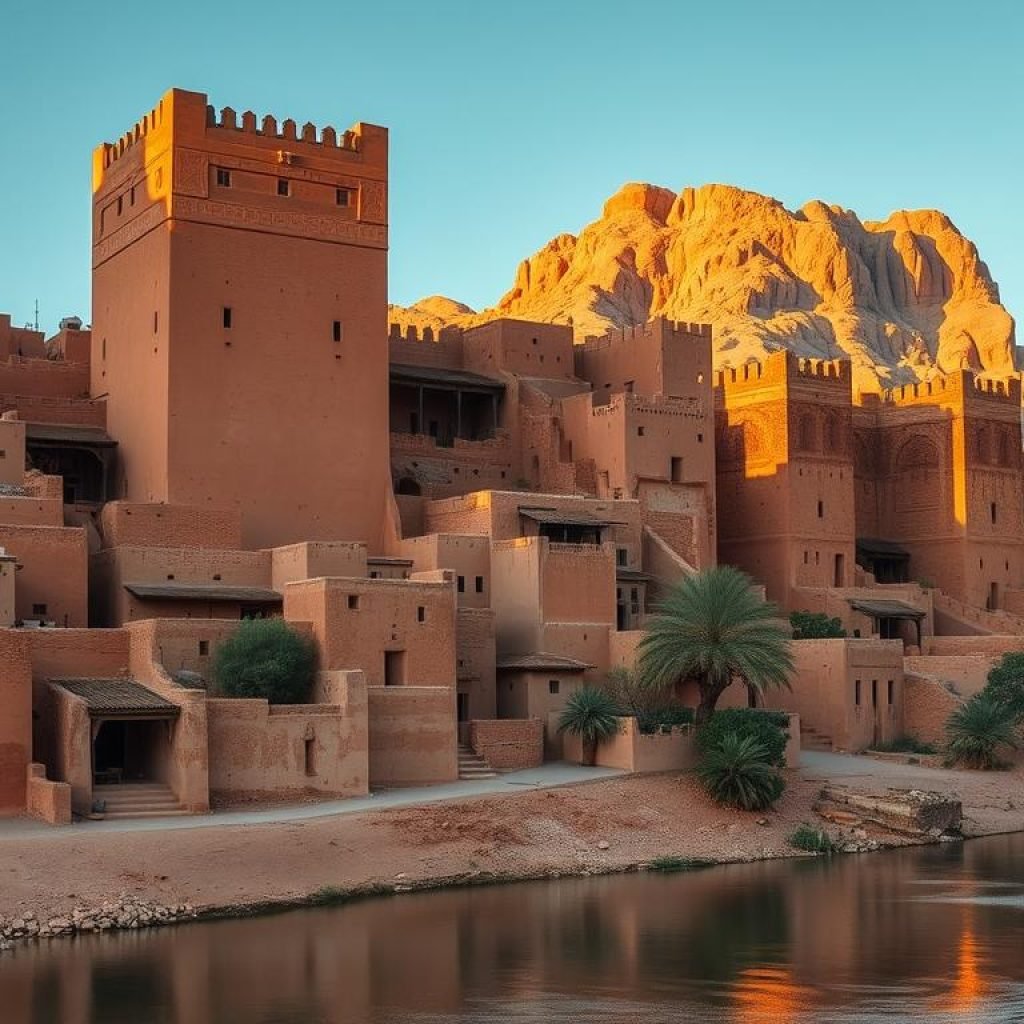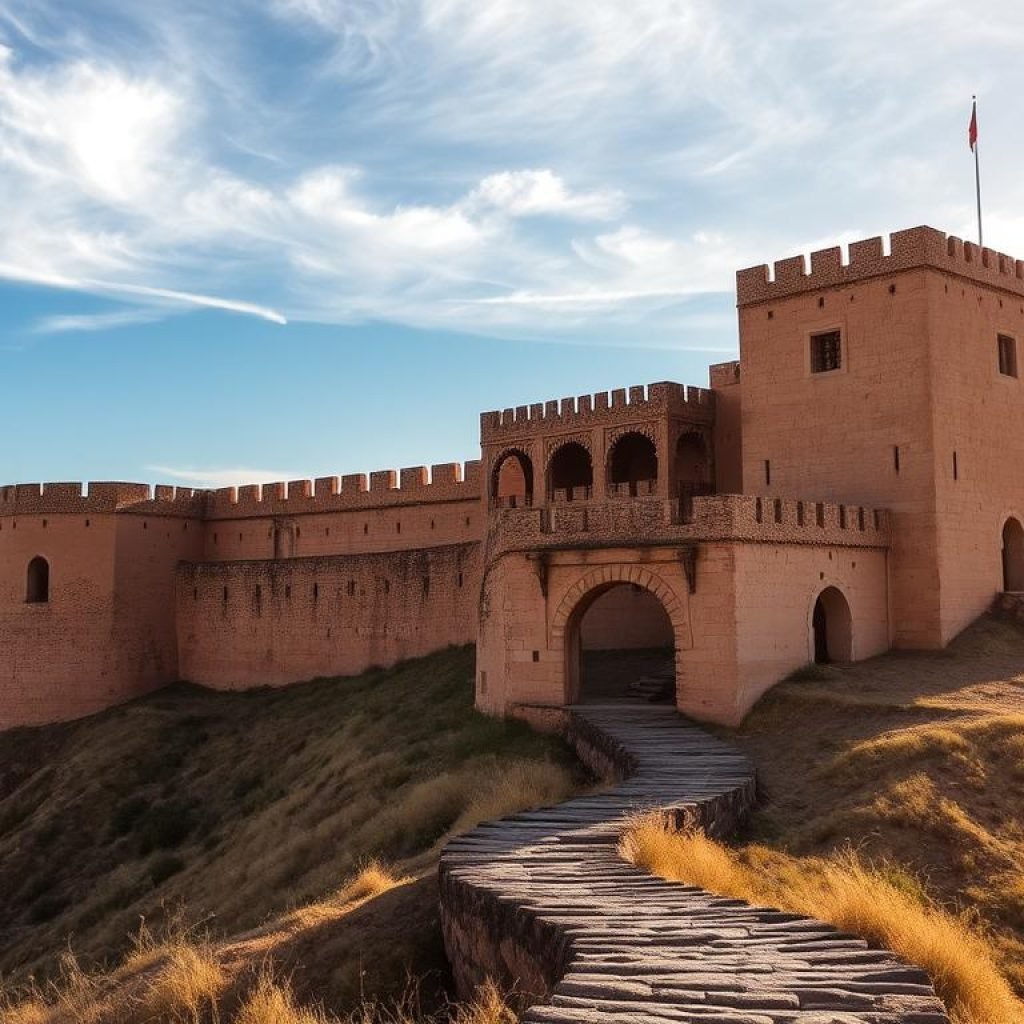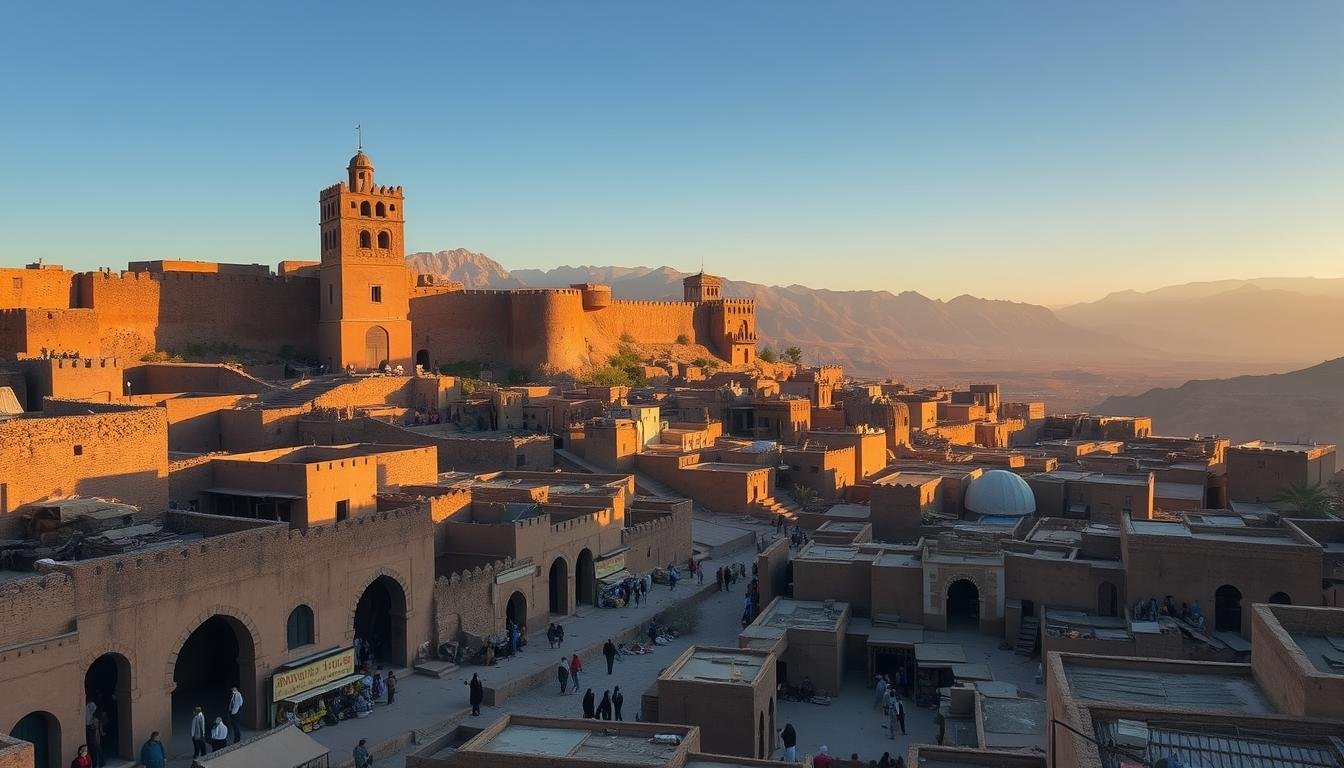Morocco is a country with a rich history. Its ancient fortresses show this well. These structures were influenced by Jewish, Arab, and Berber cultures. They have shaped Morocco’s cultural identity.
The Kasbah of Ait Benhaddou is a great example. It combines different architectural styles and is historically significant. The Jewish community in Morocco also played a big role in the country’s history. They contributed to its culture and economy.
Ancient fortresses in Morocco remind us of the country’s complex past. The Atlas Mountains and coastal cities are home to these fortresses. The Jewish community in Morocco, found in cities like Marrakech and Fes, is an important part of this history.
Many Jewish Moroccans have made significant contributions to the country. Exploring these fortresses and learning about the Jewish community in Morocco is rewarding. It offers a deep look into Morocco’s fascinating past.
Key Takeaways
- Ancient fortresses in Morocco are a testament to the country’s rich history and cultural heritage.
- The Jewish community in Morocco has had a significant impact on the country’s history and development.
- Moroccan Jewish history is an important part of the country’s narrative, with many notable figures contributing to the country’s development.
- Ancient fortresses such as the Kasbah of Ait Benhaddou showcase the country’s unique blend of architectural styles and historical significance.
- Exploring ancient fortresses in Morocco can be a rewarding and enriching experience, offering a glimpse into the country’s complex and fascinating past.
Introduction to Morocco’s Ancient Fortresses
Morocco’s history shines through its ancient fortresses. These structures have guarded the country against invaders. The country’s spot at the crossroads of the Mediterranean, Africa, and Arab worlds made it a key target. Morocco Jewish heritage tours let you see the Jewish synagogues and dive into Jewish culture in Morocco.
The fortresses in Morocco show the impact of history, like Muslim Spain and sub-Saharan Africa. The Berber people have kept their freedom, mixing cultures. This mix includes the Jewish culture in Morocco, seen in architecture, art, and traditions.
Visitors can see the ancient fortresses and learn about Morocco’s history and culture. The Jewish synagogues in Morocco are a big part of its heritage. Morocco Jewish heritage tours offer a special chance to understand the Jewish community’s history and culture in Morocco.
1. Kasbah of Ait Benhaddou
The Kasbah of Ait Benhaddou is a UNESCO World Heritage Site. It’s one of Morocco’s most famous ancient fortresses. Located near Ouarzazate, it shows the country’s rich history and culture. The kasbah’s unique style was influenced by Sephardic Jews Morocco.
It sits on a key trade route. This made it a hub for trade and cultural exchange.
Some key features of the Kasbah of Ait Benhaddou include:
- UNESCO World Heritage Site designation: 1987
- Total area of the Ksar: 3.03 hectares
- Buffer zone area: 16.32 hectares
- Strategic location along the trans-Saharan trade route
The Kasbah of Ait Benhaddou has been in films like “Gladiator” and “Game of Thrones.” This shows its cultural importance. Visitors can explore and learn about its history and Moroccan culture.

Historical Background
The Kasbah of Ait Benhaddou dates back to the 11th century. The current buildings started in the 17th century. Its history shows the cultural exchange and trade in the region, including Sephardic Jews Morocco’s influence.
Architectural Features
The Kasbah of Ait Benhaddou has a unique style. It uses traditional construction methods and materials. Its design reflects its cultural significance and Moroccan history.
Visitors can explore and learn about its architecture. This includes its Berber architecture and influence from Sephardic Jews Morocco.
UNESCO World Heritage Status
The Kasbah of Ait Benhaddou was named a UNESCO World Heritage Site in 1987. This recognizes its cultural value and importance in Moroccan history. Visitors can learn about its history and cultural significance, including its connection to the Jewish museum Morocco and Sephardic Jews Morocco.
2. Essaouira Fortress
Essaouira Fortress is at 31°30′47″N 9°46′11″W. It’s a key ancient fortress in Morocco, filled with history and culture. The fortress shows the Jewish heritage Morocco through its architecture. It was built in 1769 by Sultan Mohammed III, with roots going back to the 5th century BC.
The city’s Moroccan Jewish history is fascinating. In the 18th century, nearly half of the people were Jewish. Today, visitors can see the fortress and learn about its past. They can also discover how the Jewish community Morocco shaped the city. For more on Moroccan culture, check out Moroccan family culture.
Some important facts about Essaouira Fortress are:
- Founded in 1769 by Sultan Mohammed III
- Coordinates: 31°30′47″N 9°46′11″W
- Population of Essaouira: 77,966 inhabitants (as of 2014)
- UNESCO World Heritage Site designation: 2001
3. Agadir Oufella
Agadir Oufella is an ancient fortress in Agadir, Morocco. It dates back to the 16th century. The fortress shows the mix of cultures, including Jewish communities. Visitors can see the ruins and learn about its history.
The fortress is key to Moroccan heritage. Efforts are made to keep its cultural value, like Jewish synagogues Morocco and Jewish culture in Morocco. Morocco Jewish heritage tours are offered for those wanting to know more about Jewish history in Morocco.
Some important facts about Agadir Oufella include:
- Location: Agadir, Morocco
- Beginning date of construction: 16th century
- Year of major restoration: 2020
- Height of the fortress: 236 meters above sea level

To get to Agadir Oufella, visitors can take a cable car. It covers 1.7 km in about 6 minutes. The inscription on the southern side reads: “God, the Homeland, the King.” Sultan Mohammed Ech-sheikh Saâdi built it in 1540 to fight against Portuguese interests.
4. The Kasbah of Telouet
The Kasbah of Telouet is a key ancient fortress in Morocco. It has a deep history and cultural value. It sits high above the Atlas Mountains, where peaks reach over 10,000 feet.
The Glaoui family started building it in 1860. It took about 5 years to finish, with 300 craftsmen’s help.
The kasbah’s design shows the mix of Sephardic Jews Morocco and local cultures. Visitors can see its history and learn about its role in Moroccan heritage. For more on Morocco’s Jewish community, the Jewish museum Morocco is a great place to visit.
- Reception rooms that required 3 years to construct and involved 300 men, including plaster workers, carvers, and one painter
- A unique blend of Moorish architecture and local influences
- A testament to the region’s rich history and cultural significance
The kasbah is among Morocco’s ancient fortresses. It shows the country’s rich history and cultural variety. Visitors can explore and learn about its role in Moroccan history and the Sephardic Jews Morocco’s impact on local culture.
5. Chefchaouen’s Kasbah
Chefchaouen’s Kasbah is a key ancient fortress in Morocco. It has a rich history and cultural importance. The kasbah shows the influence of the Jewish community in Morocco, with its architecture reflecting this cultural exchange.
Founded in 1471, the kasbah sits at 564 m (1,850 ft) high. It has 10 towers that strengthen its walls.
The Jewish heritage in Morocco is clear in the kasbah’s design. It combines Moroccan and Jewish architectural styles. Many Jewish families lived and traded here, making the kasbah a part of Moroccan Jewish history.
Today, visitors can explore the kasbah. They can learn about its history and the role of the Jewish community in Morocco.
Some key features of Chefchaouen’s Kasbah include:
- 10 towers reinforcing the kasbah walls
- A unique blend of Moroccan and Jewish architectural styles
- A rich history dating back to 1471
- Influence from the Jewish community Morocco and Moroccan Jewish history

The kasbah is a vital part of Moroccan heritage. Its cultural significance is celebrated today. Chefchaouen’s Kasbah is a must-see for those interested in Jewish heritage in Morocco.
Conclusion: Preserving Morocco’s Heritage
Exploring Morocco’s ancient fortresses shows they are more than old buildings. They are key parts of the country’s culture. Places like the Kasbah of Ait Benhaddou and Essaouira Fortress tell stories of Morocco’s past. They show how different cultures, including Jewish communities, have shaped the country.
It’s important to keep these fortresses safe. They help keep Morocco’s culture alive. They also attract tourists and teach people about history and culture. By working together, we can protect these sites and share them with the world.




Comment (0)